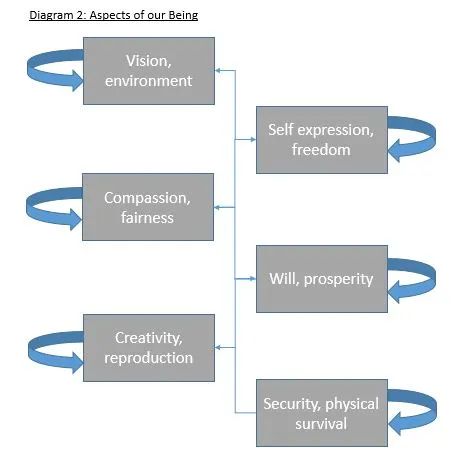In this introduction, I would like to share my thoughts on what an integrative philosophy is and how it relates to the human condition. I will discuss some possible principles, illustrate some diagrams, share a poem and give an example of my own personal story.
Principles
Some principles of an integrative philosophy may include:
- Everything starts with a breath, paying attention to what is at hand, in the heart or on one’s mind; the corner stone will be self-awareness which extends to a deeper identity.
- There is a need to have respect for all values, each value needs to be included in an integrative philosophy; communication will be vital and openness will be necessary to understand each other’s views.
- The 2 underlying aims are:
a. Evolution: increase consciousness and conscience, see things more clearly, feel things more deeply and have action follow this awareness and compassion.
b. Involution: be involved, relate, contribute, play, dance, be the author of your own personal story, live a path with heart. - Different values often clash, frequently in a direction of division; division and integration can be healthy or unhealthy depending on aim - the compass for this philosophy is the underlying aims of evolution and involution.
- Different levels of consciousness and aspects of being (physical, emotional, intellectual and spiritual) are found and available within all of us.
- Each person has their own unique makeup and we all have different centers of gravity within our being; we frequently find ourselves in multiple groups and multiple roles, each with their own center of gravity.
- These ideas themselves exist on different levels and require different details and emphasis based on those levels.
Forms of Expression
In order to communicate any integrative philosophy, one would need to express ideas in many different forms in order to be as inclusive as possible, including descriptions, diagrams, stories, movement, art, music, poetry, and practical exercises.
Diagrams
Below are 2 diagrams that I will explain in more detail, frequently reference and provide examples for in future posts. It is a synthesis of a number of western and eastern philosophy ideas that I have studied and learned from others.


Poem
Here is an example of a poem that I wrote which illustrates an integrative philosophy.
When the Invisible Hand Meets the Warmth of Heart
Farewell to the day when division resides in its extremity,
And when the Earth no longer weeps its patient tears,
Whereby the invisible pocket and slight of hand are brought to light,
And inequality of opportunity and lack of freedom of choice are no more.
Let's welcome the day when both the Earth and Humanity can smile together,
Where we are both agents and recipients of balanced well being,
Where privilege and responsibility align,
And when the invisible hand meets the warmth of heart.
Practical Self Work
Listen more closely to someone whom you are very different from and watch the source of the reaction.
Personal Reflections
Every day, I see a world divided and my contact with colleagues, friends and family feels disconnected, I am in a bubble and others, I believe, are in their own bubbles. We are not in contact, almost like 2 automatons (a sophisticated bundle of habits on automatic pilot) stumbling in the night. My most important relationships are with my family, I need to better connect with my wife and daughters, there are parts of me that needs to grow and be open such that I can better relate to them. Time is precious, why wait?
Aspects of an integrative philosophy have helped me and I am hoping that they may be of use to others and perhaps through sharing, we may grow together.
